35 Best Places To Visit In Jaisalmer | Top Things To DO | Jaisalmer Tourism
Jaisalmer, often referred to as the “Golden City,” is a captivating destination nestled in the heart of the Thar Desert in the Indian state of Rajasthan. Renowned for its majestic sandstone architecture that takes on a mesmerizing golden hue in the sunlight, Jaisalmer stands as a testament to the rich history and cultural heritage of the region. The city is dominated by the imposing Jaisalmer Fort, a UNESCO World Heritage Site, which rises dramatically from the arid landscape and offers panoramic views of the surrounding desert. The narrow winding lanes within the fort are lined with intricately carved havelis, showcasing exquisite craftsmanship and telling tales of a bygone era. Jaisalmer is also famous for its vibrant markets and bustling bazaars where one can explore a myriad of handicrafts, textiles, and traditional Rajasthani artifacts. The city is a hub for camel safaris, allowing visitors to experience the magic of the desert, complete with undulating sand dunes that stretch as far as the eye can see. Cultural events, such as the Desert Festival, further enhance the allure of Jaisalmer, offering visitors a glimpse into the colorful traditions, folk music, and vibrant dance forms of Rajasthan.
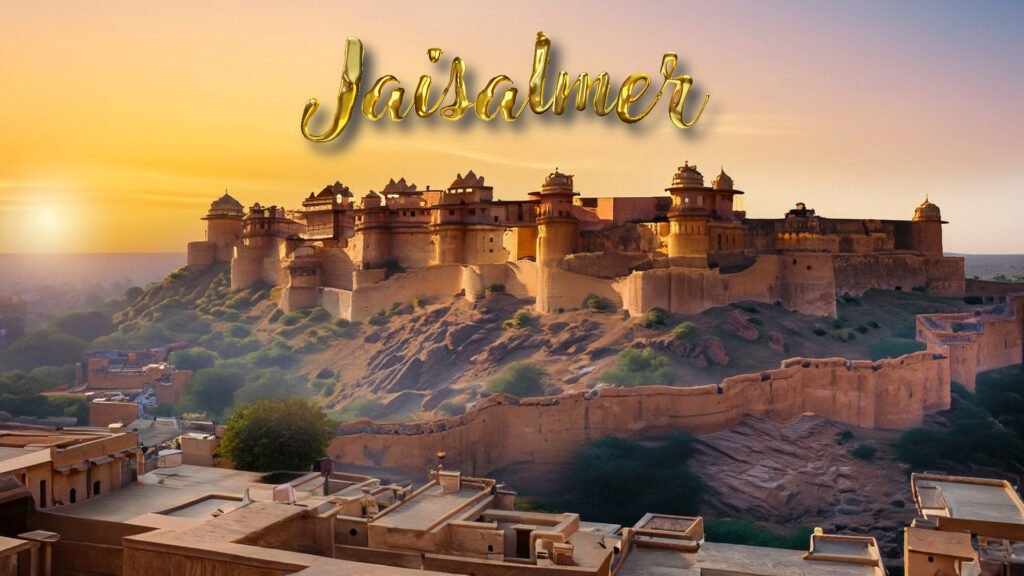
Best Places To Visit In Jaisalmer:
Jaisalmer, Renowned for its mesmerizing sandstone architecture that takes on a golden hue in the sunlight, Jaisalmer offers a unique blend of history, culture, and natural beauty, Intricately carved havelis, and enchanting Sam Sand Dunes offering camel safaris in the Thar Desert. Explore the city’s rich history, architecture, and cultural heritage at places like Jaisalmer Fort, Patwon Ki Haveli, and Gadsisar Lake. Here are some of the top places to visit in Jaisalmer:-
1. Jaisalmer Fort (Sonar Quila)
Jaisalmer Fort, also known as Sonar Quila or the Golden Fort, stands as an architectural marvel in the heart of the Thar Desert, overlooking the bustling city of Jaisalmer in Rajasthan, India. This imposing fortification, built in 1156 AD by Rajput ruler Rawal Jaisal, is one of the largest fully preserved fortified cities in the world and a UNESCO World Heritage Sit. The fort is renowned for its golden-yellow sandstone construction, which glows during sunrise and sunset. The massive fort houses intricate havelis, such as Patwon Ki Haveli and Salim Singh Ki Haveli, showcasing rich carvings and balconies. Temples within the fort, like the Jain Temples, boast exquisite architecture. With narrow winding lanes, the fort offers a glimpse into the opulent lifestyle of the past. It stands as a living heritage site, symbolizing Jaisalmer’s cultural richness in the heart of the Thar Desert. The Jaisalmer Fort is open daily from 9:00 am to 6:00 pm. Entry costs INR 50 for Indian nationals and INR 250 for foreigners. Additional fees apply for camera or video camera usage.
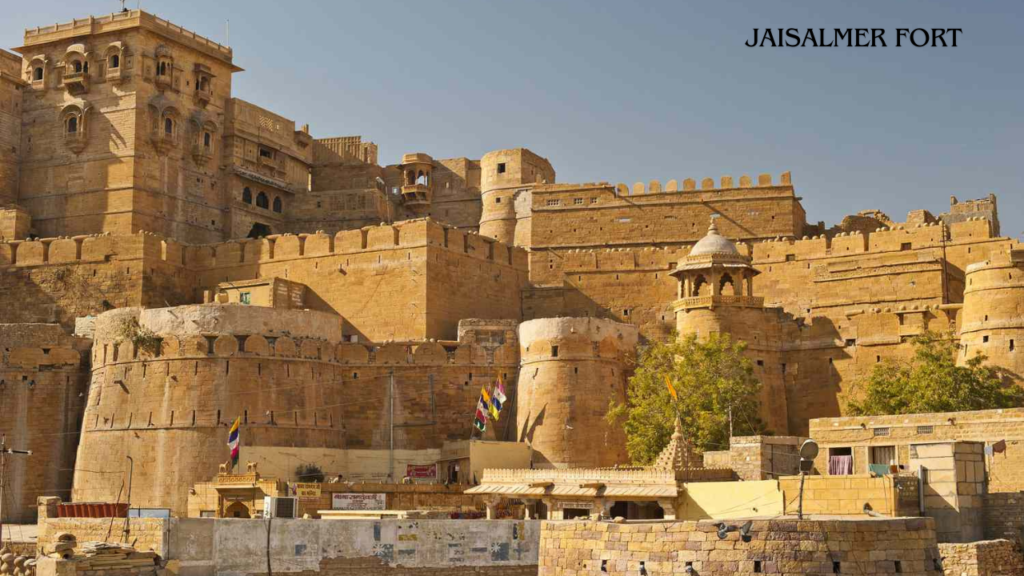
2. Patwon Ki Haveli
Patwon Ki Haveli is a cluster of five historic mansions located in the heart of Jaisalmer. Built in the 19th century, these intricately crafted havelis are a masterpiece of architecture and showcase the opulence of the wealthy trader community of that era. These havelis showcase the opulence of the wealthy traders with stunning facades, detailed carvings, ornate balconies, and distinctive yellow sandstone architecture. Originally constructed for the Patwa family, prominent gold and silver traders, the havelis offer visitors a glimpse into the prosperous lifestyle of the past. With rich interiors featuring decorated rooms and antique furnishings, Patwon Ki Haveli stands as a testament to Jaisalmer’s cultural and architectural heritage, attracting tourists with its historical significance and aesthetic charm. Patwon Ki Haveli is open daily from 9:00 am to 5:00 pm. Entry costs INR 50 for Indian nationals and INR 250 for foreigners.
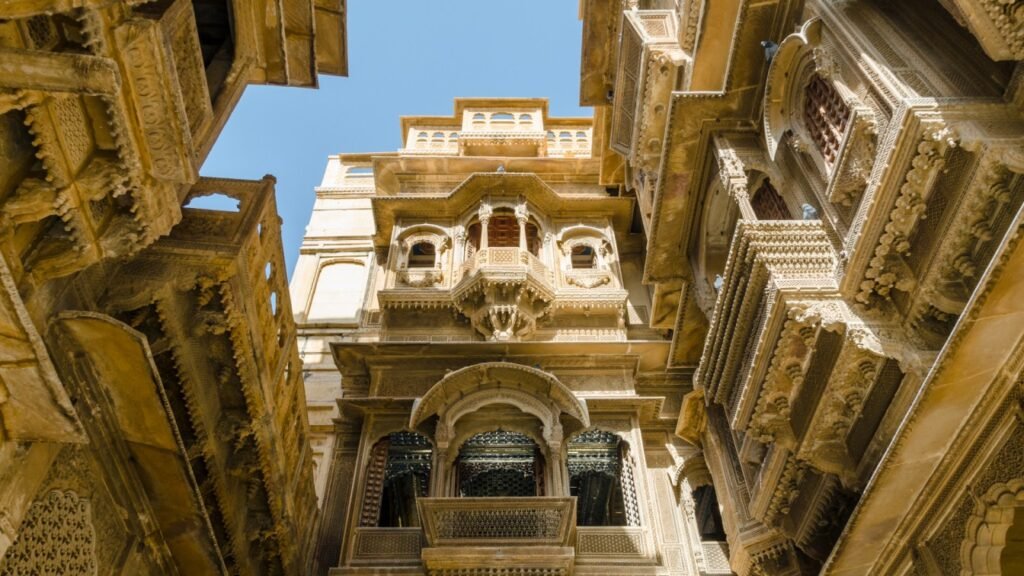
3. Sam Sand Dunes
Sam Sand Dunes is a captivating destination known for its vast expanses of golden sand dunes. Renowned for its picturesque landscapes, especially during sunrise and sunset, the dunes attract visitors seeking a quintessential desert experience. Camel safaris offer a popular means to explore the undulating terrain, while cultural performances against the backdrop of the dunes provide a unique and immersive encounter. Staying overnight in desert camps enhances the experience, allowing travelers to enjoy traditional Rajasthani cuisine and cultural activities under the starlit desert sky. Sam Sand Dunes encapsulate the stark yet stunning beauty of the Thar Desert, providing an unforgettable escape into the enchanting world of shifting sands.

4. Gadisar Lake
Gadisar Lake is a serene artificial reservoir built in the 14th century by Maharaja Gadsi Singh. Originally constructed for water conservation, the lake is surrounded by sandstone temples, ghats, and chattris. The entrance, marked by the Tilon Ki Pol gateway, features intricate carvings. A popular retreat, the lake attracts migratory birds, and boat rides allow visitors to explore its architectural and natural beauty. With historical significance and vibrant festivals like Gangaur celebrated on its shores, Gadisar Lake offers a peaceful blend of history, culture, and scenic charm in the heart of Jaisalmer.
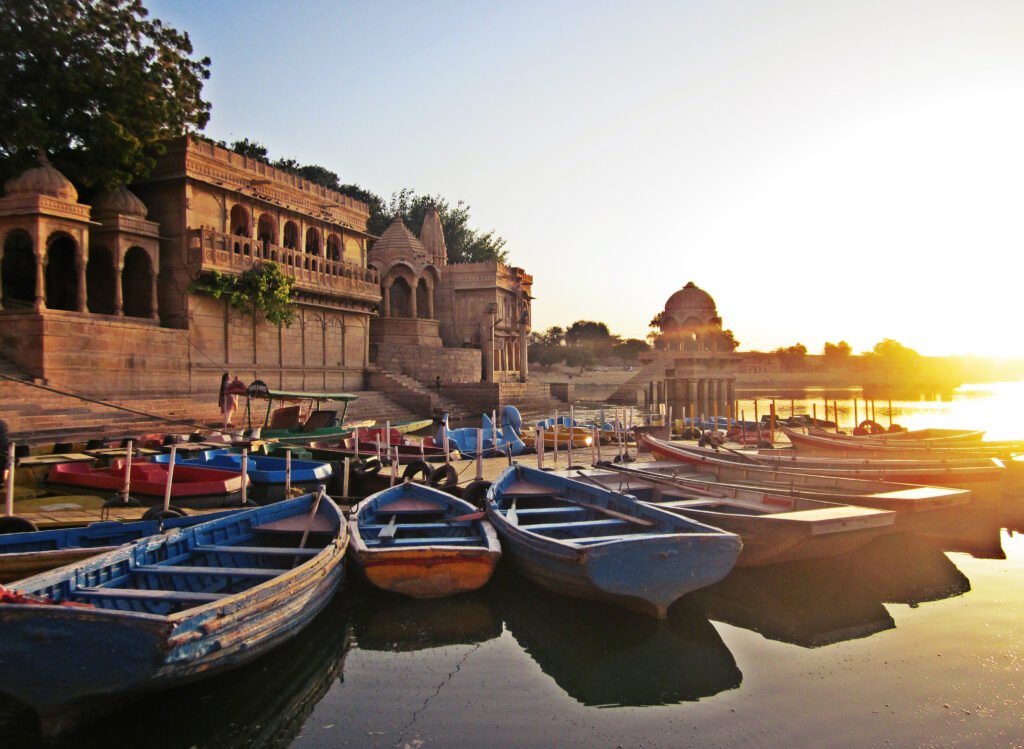
5. Nathmal Ki Haveli
Nathmal Ki Haveli is a captivating architectural masterpiece built in the late 19th century by two brothers, Hathi and Lulu. The haveli is known for its unique design, with each brother working on a different side without communication, resulting in a splendid fusion of Rajput and Islamic styles. The intricate carvings, ornate balconies, and detailed facades depict floral patterns, animals, and more. The interiors showcase finely carved furniture and walls that narrate the grandeur of the bygone era. Nathmal Ki Haveli stands as a testament to the craftsmanship of its builders and offers a glimpse into the regal heritage of Rajasthan.

6. Kuldhara Abandoned Village
Kuldhara, an abandoned village, holds a mysterious and haunting allure. Believed to have been inhabited by the Paliwal Brahmins in the 19th century, the village now stands as a ghost town with empty, dilapidated houses and crumbling structures. Legend has it that the village was deserted overnight in the early 1800s under mysterious circumstances. According to local folklore, the Paliwal Brahmins, who were the original inhabitants, left the village due to persecution and an unjust tax imposed by the ruling minister. It is said that the villagers cursed the land, making it uninhabitable for anyone thereafter. Kuldhara’s abandoned state adds to its eerie atmosphere, and the desolation of the village has fueled numerous myths and ghost stories over the years. The remnants of the once-thriving community include dilapidated homes, a decaying temple, and narrow, deserted lanes that echo with a sense of abandonment.

7. Salim Singh Ki Haveli
Salim Singh Ki Haveli is an 18th-century mansion built by Salim Singh, the prime minister of Jaisalmer. Notable for its distinctive peacock-shaped architecture and intricate carvings, the haveli showcases a fusion of Rajput and Islamic styles. The balconies, resembling peacocks, are intricately designed. The interiors feature ornate rooms with frescoes, mirror work, and finely carved walls, offering a glimpse into the opulent lifestyle of the nobility. Today, the haveli is a popular tourist attraction, representing the rich cultural heritage of Jaisalmer and captivating visitors with its architectural beauty and historical significance. The haveli is open from 8:00 AM to 6:00 PM on all days of the week. The entry fee for Indians is Rs 10 and for foreigners, it is Rs 15.

8. Tazia Tower
Tazia Tower, adds a touch of elegance to the city’s skyline. This intricately crafted five-story structure stands as a prominent attraction, showcasing the impressive craftsmanship of the local artisans. Built in the late 19th century, Tazia Tower was constructed by Muslim craftsmen to honor the architectural traditions of their homeland. The tower is a series of intricately designed balconies, each representing a different region of Muslim craftsmanship. These balconies are adorned with delicate carvings, arches, and finials, creating a stunning display of architectural finesse. Tazia Tower is particularly significant during the Muharram procession when colorful Tazias (replicas of mausoleums) are paraded through the city and eventually offered at the tower. This annual event adds cultural and religious significance to the monument, attracting both locals and tourists.

9. Jaisalmer War Museum
Jaisalmer War Museum, situated near the military station in Jaisalmer, stands as a tribute to the valor and sacrifices made by the Indian armed forces. Established with the aim of preserving the rich military history of the region, the museum showcases a diverse collection of exhibits related to India’s defense forces. The museum displays a wide range of military vehicles, aircraft, and equipment used in various wars. Inside, galleries feature artifacts, photographs, and information panels highlighting the stories of courageous soldiers involved in different conflicts, including the Indo-Pak wars. The epitaph gallery serves as a poignant homage to those who made the ultimate sacrifice. The museum aims to preserve and educate visitors about India’s military history, fostering a sense of patriotism and appreciation for the armed forces’ dedicated service. military operations. The museum is open from 10:00 AM to 6:00 PM every day, and the entry fee is Rs. 55 per person.

11. Kothari’s Patwaon Ki Haveli
Kothari’s Patwaon Ki Haveli is a 19th-century architectural masterpiece built by the affluent Kothari family. Comprising five intricately designed havelis, the structure is renowned for its opulent craftsmanship, featuring detailed carvings, balconies, and jharokhas. The interior is adorned with vibrant frescoes, mirrors, and elaborately carved doors, offering a glimpse into the prosperous lifestyle of the merchant class during that era. The haveli stands as a testament to Jaisalmer’s rich cultural and architectural heritage, attracting tourists interested in exploring its historical and artistic significance. The haveli is open from 9:00 AM to 5:00 PM on all days of the week. The entry fee for Indians is Rs 20 and for foreigners, it is Rs 100.
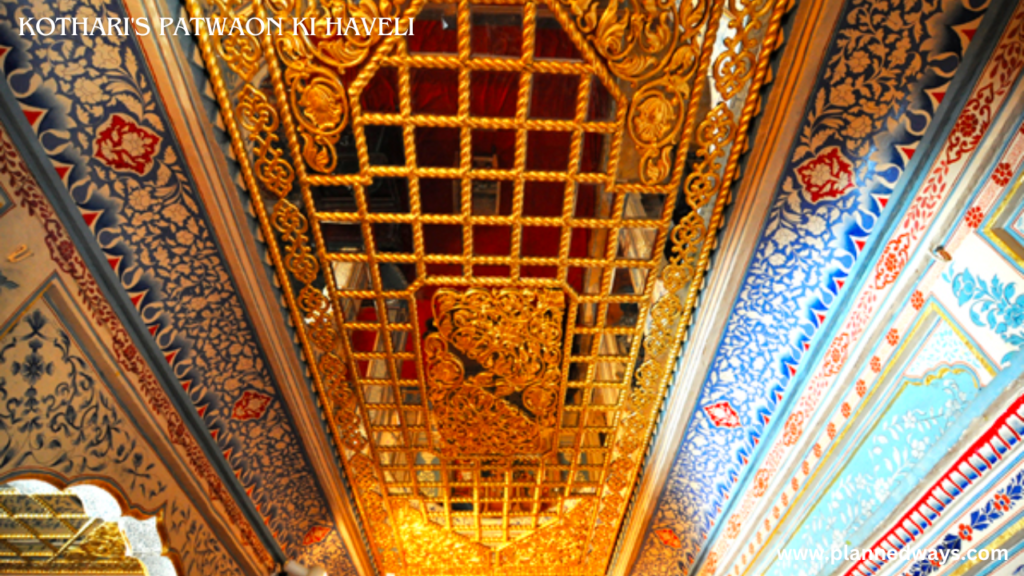
12. Chandraprabhu Jain Temple
The Chandraprabhu Jain Temple stands among the seven Jain temples within the Jaisalmer Fort in Rajasthan. Dedicated to Chandraprabha, the eighth Tirthankara of Jainism, the temple portrays him with a distinctive crescent moon symbol on his chest. Constructed in 1509 CE using yellow sandstone, it exemplifies the Rajput style of architecture. Renowned for its detailed carvings, frescoes, mirrors, and ornamental arches (toranas), the temple is a testament to artistic finesse. In addition to its religious significance, the temple accommodates a library containing ancient manuscripts and paintings. A revered pilgrimage site for Jains and a compelling tourist attraction, the Chandraprabhu Jain Temple beckons visitors with its historical and cultural allure.
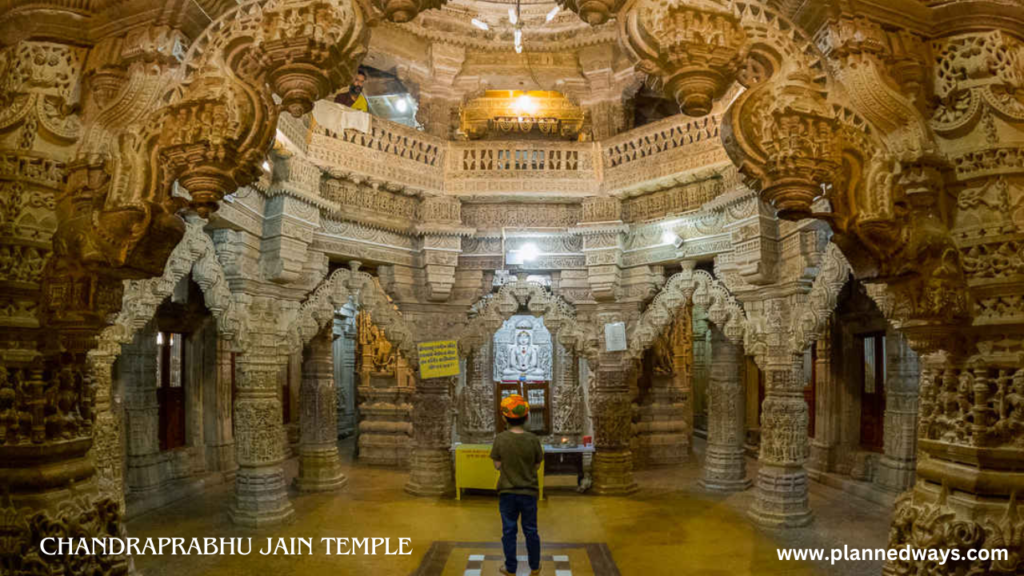
13. Bada Bagh
Bada Bagh is a historical garden complex built in the 19th century. It features a series of intricate cenotaphs called chhatris, dedicated to the royal families of Jaisalmer. The chhatris showcase a blend of Rajput and Mughal architectural styles against the backdrop of the Thar Desert. The main cenotaph honors Maharawal Jai Singh II, offering visitors a serene oasis and panoramic views of the desert landscape. Bada Bagh stands as a testament to the cultural and historical richness of Jaisalmer, attracting history enthusiasts and travelers exploring Rajasthan. The entry fee for Bada Bagh is Rs 100 per person, with a photography option available at an additional charge of Rs 150. The site is open daily from 8 AM to 6 PM.
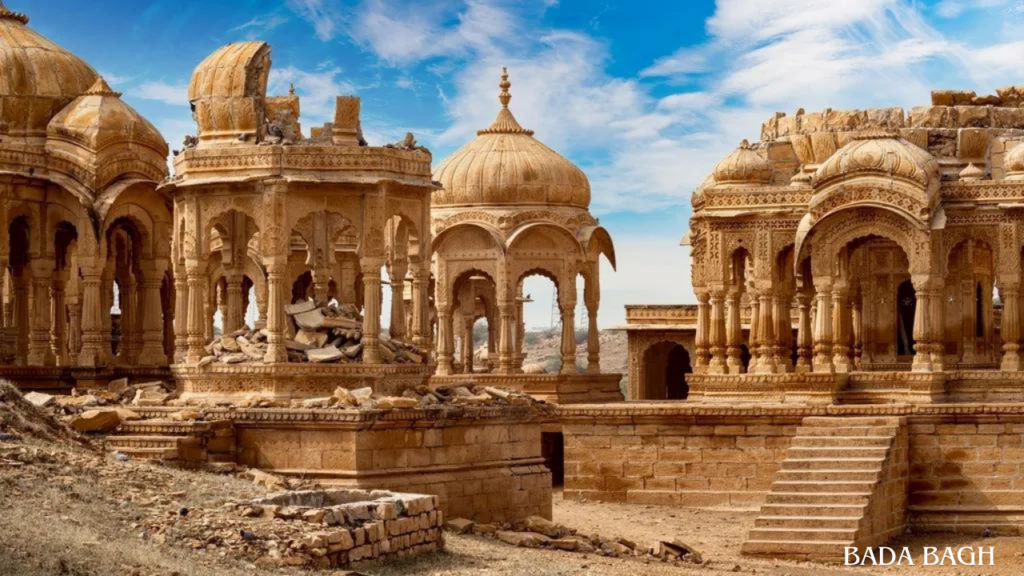
14. Desert National Park
Desert National Park is a captivating natural reserve. Established to preserve and showcase the unique desert ecosystem, the park spans over 3,000 square kilometers and is renowned for its diverse wildlife, including rare species adapted to the arid conditions. The park is home to a variety of flora and fauna, with native plants like the thorny shrub and animals like the blackbuck, chinkara, and desert fox thriving in this harsh environment. The park’s landscape features undulating sand dunes, rocky formations, and salt lakes, providing a stunning backdrop for nature enthusiasts and wildlife photographers. The park operates from 10:00 AM to 5:00 PM year-round. The entry fee is INR 100 for Indian visitors and INR 300 for foreigners. Jeep safari fees typically amount to INR 100 per person, while camel ride costs vary. Additionally, hiring a guide for a more in-depth understanding of the park’s history and ecology is possible at a fee of INR 200.

15. Desert Culture Centre & Museum
The Desert Culture Centre & Museum is a vibrant institution dedicated to showcasing the cultural heritage of the Thar Desert. Through a diverse collection of artifacts, exhibits, and information, the museum provides a comprehensive glimpse into the traditional lifestyle, art, music, and crafts of the desert communities. Visitors can explore displays featuring textiles, musical instruments, folk art, and historical items, offering a rich understanding of the unique culture of the region. The museum serves as a valuable educational resource, preserving and promoting the rich heritage of the Thar Desert communities in Rajasthan.The timings of the museum are from 10:00 AM to 6:00 PM every day. The entry fee for the museum is INR 50 per person. The fee for the puppet show, which is held from 6:30 PM to 8:00 PM, is also INR 50 per person. The camera fee is INR 20 for a still camera and INR 50 for a video camera.

16. Sonee Art Gallery
Sonee Art Gallery specializes in showcasing exquisite miniature paintings on silk, skillfully crafted by local artists. The collection features diverse themes including desert landscapes, wildlife, religious figures, and historical events. Beyond art appreciation, the gallery extends a warm welcome to visitors, offering tea and snacks. Additionally, it provides convenient packing and shipping services for purchased artworks. Sonee Art Gallery stands as a unique venue where patrons can both admire and acquire the distinctive and beautiful art reflective of the Thar Desert region. The gallery is open from 8:00 AM to 7:00 PM on all days of the week.

17. Roj Camel Safari
Roj Camel Safari offers an immersive and adventurous experience in the heart of the Thar Desert near Jaisalmer. This camel safari provider allows visitors to explore the captivating desert landscape while riding on the “Ship of the Desert,” the camel. The safari typically includes a journey through golden dunes, providing a scenic and tranquil setting for travelers. Roj Camel Safari caters to both day and overnight tours, allowing participants to witness breathtaking sunsets and sunrises against the backdrop of the vast desert expanse. The safari includes cultural performances, traditional meals, and stargazing opportunities, providing an authentic and enriching adventure in the heart of the desert landscape. Roj Camel Safari offers varying packages with different costs per person. A half-day tour is INR 800, a full-day tour is INR 1500, and an overnight tour is INR 2000, inclusive of camel ride, guide, meals, water, and camping equipment. Multiple-day tours have different rates depending on the itinerary and facilities provided.

18. The Thar Heritage Museum
The Thar Heritage Museum is a cultural treasure showcasing the rich history and heritage of the Thar Desert. Founded by Laxmi Narayan Khatri, the museum features a diverse collection of artifacts, textiles, photographs, and exhibits depicting the traditional lifestyle, folk art, architecture, and daily life of the Thar Desert communities. With informative displays, it serves as a valuable resource for understanding and preserving the cultural tapestry of the region, making it a must-visit for those interested in the history and traditions of the Thar Desert. The museum is open daily from 9:00 AM to 8:00 PM, with an entry fee of INR 30 for Indians and INR 70 for foreigners. The puppet show, from 6:30 PM to 8:00 PM, has a separate fee of INR 50 per person. Camera usage costs INR 20 for still cameras and INR 50 for video cameras.

19. Vyas Chhatri
Vyas Chhatri, This stunning cenotaph, also known as Vyas Ki Samadhi, is dedicated to Sage Vyas, a revered figure in Hindu mythology credited with composing the epic Mahabharata. Perched on the banks of the Amar Sagar Lake, Vyas Chhatri is characterized by its intricate carvings, grand architecture, and distinctive Rajasthani design. Constructed from golden-yellow sandstone, a hallmark of Jaisalmer’s architecture, the cenotaph features ornate carvings depicting mythological figures and intricate patterns. The site holds cultural and historical significance as it pays homage to Sage Vyas and serves as a cremation ground for the Brahmin community.

20. Maharaja’s Palace
Maharaja’s Palace was built in the 12th century by Maharaja Jaisal Singh, the founder of Jaisalmer, and later expanded and renovated by his successors. The palace is a blend of Rajput and Islamic architectural styles, featuring carved stone screens, ornate balconies, and intricate jharokhas. The palace also houses a museum that displays various artifacts, weapons, textiles, and paintings related to the royal history and culture of Jaisalmer. The entry fee is INR 250 for Indian visitors and INR 500 for foreigners.
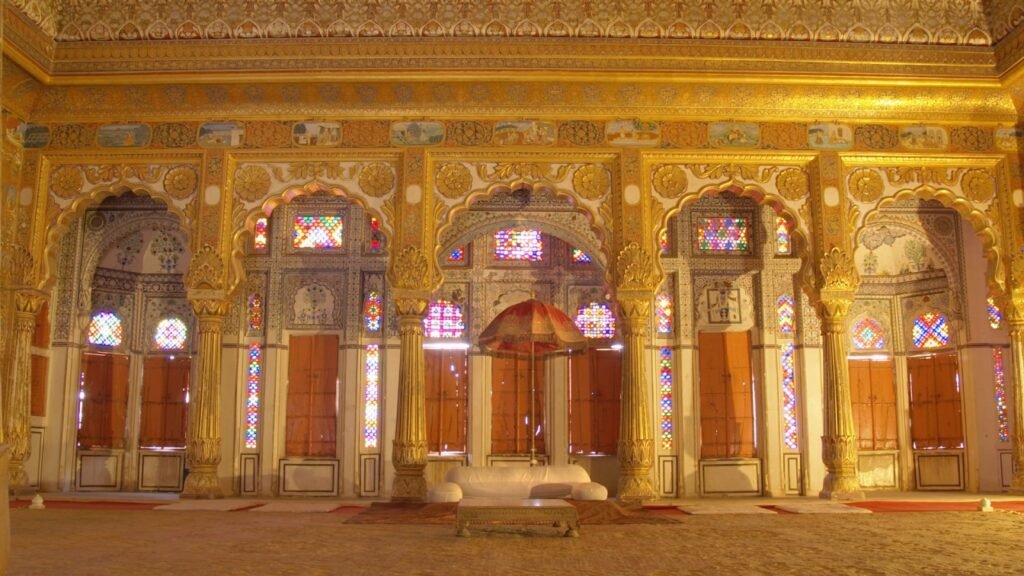
21. Surya Gate
Surya Gate is a prominent gateway that stands as a testament to the city’s rich cultural and architectural heritage. This imposing structure, also known as the Sun Gate, serves as one of the entry points to the Jaisalmer Fort. Constructed with golden-yellow sandstone, characteristic of Jaisalmer’s architecture, Surya Gate features intricate carvings and detailed craftsmanship. The gate is named after the Hindu Sun God, Surya, and its design reflects a blend of Rajput and Mughal architectural styles. Beyond its aesthetic appeal, Surya Gate holds historical significance as it was traditionally the main entrance for the royal processions. Visitors passing through the gate are greeted by the vibrant lanes and alleys of the Jaisalmer Fort, offering a glimpse into the city’s medieval charm.

22. Manak Chowk & Haveli
Manak Chowk and Haveli in Jaisalmer, form a dynamic cultural complex. Manak Chowk is a lively market offering a variety of traditional Rajasthani crafts. Surrounding the square are Havelis, showcasing intricate architecture and historical significance. Notable is Nathmal Ji Ki Haveli with its unique twin facades. Together, Manak Chowk and Haveli provide a rich experience, allowing visitors to explore local heritage, shop for traditional items, and admire the architectural marvels that contribute to the historical charm of Jaisalmer.

23. Amar Sagar Lake
Amar Sagar Lake, This artificial reservoir, constructed in the 17th century by Maharawal Amar Singh, serves both as a water conservation tank and a picturesque destination. Surrounded by striking architecture, including the Chattris (cenotaphs) of Amar Singh, the lake offers a tranquil escape with its reflective waters mirroring the surrounding landscapes. The Chattris around Amar Sagar Lake are beautifully adorned with intricate carvings and serve as memorials to the royal family of Jaisalmer. The combination of the lake, Chattris, and the scenic desert backdrop creates a captivating ambiance. Visitors can appreciate the historical and architectural significance of Amar Sagar Lake while enjoying a peaceful respite from the desert heat. The site stands as a testament to the aesthetic and engineering prowess of the bygone era in Jaisalmer.

24. Khaba Fort
Khaba Fort, stands as a silent witness to the tales of a bygone era. This abandoned fortress, believed to be haunted, is steeped in history and mystery. Constructed from yellow sandstone, typical of the region, Khaba Fort provides a glimpse into the traditional architecture of Rajasthan. Legend has it that the fort was once inhabited by the Paliwal Brahmins, who abandoned it due to a curse, leaving behind an eerie and desolate atmosphere. The fort complex includes ruins of houses, a temple, and remnants of a once-thriving village. Visitors can explore the narrow lanes, dilapidated structures, and experience the haunting charm that surrounds Khaba Fort.

25. Mandir Palace
Mandir Palace is a historic gem that combines architectural splendor with cultural richness. Built in the late 19th century by Maharawal Jawahir Singh, this heritage hotel was once the residence of the royal family. Adorned with intricate carvings, ornate balconies, and delicate Jharokhas (overhanging enclosed balconies), Mandir Palace showcases the distinctive blend of Rajput and Mughal architectural styles. The palace is named after its splendid “Badal Vilas,” or Cloud Palace, which offers panoramic views of the surrounding city and the Jaisalmer Fort. The Mandir Palace has an entry fee of Rs 50 per person and offers photography options. Still camera usage is priced at Rs 100, and for video cameras, it is Rs 150. The palace is open daily from 9:00 AM to 5:00 PM.

26. Baa Ki haveli
Baa ki Haveli stands as a captivating historical and cultural landmark. This five-storied stone mansion, dating back approximately 450 years, once served as the residence of Brahmin priests who offered counsel to the Jaisalmer king. Preserving its antiquity, the haveli showcases intricate wooden ceilings, elaborately carved doors and windows, and expansive balconies. Within its walls, a museum unfolds the tales of fort life through exhibits of clothing, cooking utensils, musical instruments, and fossils. Perched on the terrace, visitors are treated to a panoramic vista of the Jaisalmer fort and the golden city. Situated within the fort precinct, close to the Jain temples, Baa ki Haveli invites exploration into the rich history of the region. Baa ki Haveli welcomes visitors every day from 8:00 AM to 6:30 PM. The entry fee for individuals is Rs 50.

27. Dussehra Chowk
Dussehra Chowk stands as a bustling and expansive square situated at the heart of Jaisalmer Fort. Named after the Hindu festival of Dussehra, the square becomes a hub of vibrant celebrations during the festive season. Encircled by magnificent havelis, showcasing the intricate craftsmanship and architecture of Rajasthani culture, the square exudes cultural richness. Throughout the year, Dussehra Chowk comes alive with various cultural events, performances, and markets, creating a lively and colorful atmosphere. Beyond the square, visitors can explore nearby attractions such as the Raj Mahal Palace, the Jain Temples, and the Jaisalmer Fort Palace Museum and Heritage Centre.

28. Jaisalmer Sunset Point
Jaisalmer Sunset Point is a captivating vantage point in the enchanting city. Positioned strategically to offer breathtaking views, this spot is renowned for its mesmerizing sunset panoramas over the golden landscapes of the Thar Desert. As the sun dips below the horizon, the sky transforms into a spectrum of warm hues, casting a magical glow upon the surrounding dunes and the iconic Jaisalmer Fort. The Sunset Point provides an ideal setting for visitors to witness the beauty of nature unfold and capture unforgettable moments against the backdrop of this historic and picturesque desert city.

29. Tilon Ki Pol
Tilon Ki Pol is a historic marvel that translates to “The Gate of Tilon.” This ornate gateway stands as an architectural gem, adorned with intricate carvings and delicate craftsmanship. Constructed in the 17th century, Tilon Ki Pol served as an entrance to the Tilon Ki Haveli, a grand mansion built for the affluent Tilon family. The gate boasts exquisite details, including finely carved balconies and latticed windows, showcasing the rich artistic heritage of Rajasthan. Visitors are transported back in time as they admire the detailed designs and cultural significance embedded in this splendid structure, adding to the charm of Jaisalmer’s architectural legacy.

30. Jaisalmer Folklore Museum
Jaisalmer Folklore Museum is a cultural treasure trove. This museum serves as a vibrant repository of the region’s rich cultural heritage, offering a captivating journey into the traditions, art, and folklore of Rajasthan. Housed within an architecturally fascinating building, the museum showcases a diverse collection of artifacts, costumes, musical instruments, and artworks that narrate the tales of bygone eras. Visitors are treated to a colorful tapestry of Rajasthani folklore, providing insight into the customs, rituals, and artistic expressions that have shaped the cultural identity of this desert region. The Jaisalmer Folklore Museum stands as a captivating homage to the living history and artistic legacy of Rajasthan.The museum is open from 8:00 AM to 6:00 PM on all days of the week. The entry fee is Rs 5 per person.
31. Rishabhadeva Temple
Rishabhadeva Temple is a sacred haven that echoes with the spiritual resonance of ancient times. This Jain temple is dedicated to Lord Rishabhadeva, the first Tirthankara in Jainism. As visitors approach, the temple’s architectural grandeur becomes evident, featuring finely detailed carvings and intricate sculptures that showcase the exemplary craftsmanship of the region. Constructed in the Dilwara style, the Rishabhadeva Temple exudes a serene ambiance, inviting pilgrims and enthusiasts alike to immerse themselves in the spiritual aura. The sanctum houses an idol of Lord Rishabhadeva, and the temple complex is adorned with delicate carvings depicting Jain teachings and mythological narratives. As a revered site in Jaisalmer, the Rishabhadeva Temple stands not only as a testament to religious devotion but also as a showcase of the artistic finesse that characterizes Rajasthan’s cultural heritage.

32. Jaisalmer Art Palace
Jaisalmer Art Palace is an art gallery and a boutique that showcases the rich and diverse culture and heritage of Jaisalmer. It is located near Patwa Haveli, inside the Jaisalmer Fort, a UNESCO World Heritage Site. The gallery has four floors that display various items such as antiquities, paintings, textiles, and artifacts. The owner is very polite and welcomes the visitors with a royal hospitality. The gallery also has a roof terrace that offers a stunning night view of the illuminated fort. Jaisalmer Art Palace is a place of surprises and wonders for anyone who appreciates the beauty and craftsmanship of Rajasthani culture. The gallery is open from 8:00 AM to 6:00 PM on all days of the week.
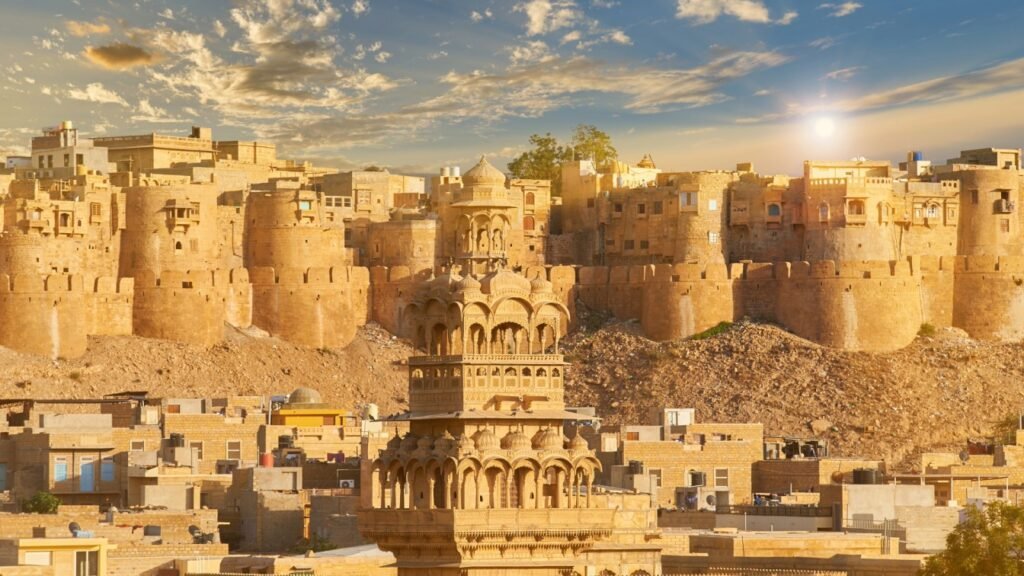
33. Amar Sagar Jain Temple
Amar Sagar Jain Temple, stands as a testament to religious and architectural splendor. This ancient Jain temple is dedicated to Lord Parshvanath, the 23rd Tirthankara in Jainism. Located near Amar Sagar Lake, the temple complex captivates visitors with its intricate marble carvings, adorned pillars, and delicate sculptures that narrate tales of Jain mythology. The temple’s serene surroundings, coupled with the reflective waters of Amar Sagar Lake, create a tranquil atmosphere, providing a peaceful retreat for devotees and admirers of art and architecture. The Amar Sagar Jain Temple is not only a spiritual destination but also a cultural gem, offering a glimpse into the artistic and religious heritage of Rajasthan.

34. Akal Wook Fossil Park
Akal Wood Fossil Park is a national geological monument and a biodiversity heritage site. It is located about 17 km from the city and covers an area of 21 hectares. The park contains fossils of trees, plants, and shells that date back to the Jurassic period, about 180 million years ago. The fossils indicate that the region was once a lush forest with a tropical climate and a sea nearby. The park has a museum that displays various fossils, including a giant petrified trunk that is 13 meters long and 1.5 meters wide. The park also has a lake that attracts migratory birds and offers a scenic view of the desert landscape. Akal Wood Fossil Park is a fascinating place to visit for history and nature lovers. The park is open from 9:00 AM to 6:00 PM on all days of the week. The entry fee is Rs 5 per person for Indians and Rs 20 per person for foreigners.

35. Lodurva
Lodurva is a village in Jaisalmer district of Rajasthan. It was the ancient capital of the Bhati Rajputs until 1156 CE, when Rawal Jaisal shifted the capital to Jaisalmer. Lodurva is famous for its Jain temples and other historical monuments that showcase the exquisite craftsmanship and architecture of the Rajasthani culture. The main attraction is the Parshvanath temple, which has a black marble idol of the 23rd Tirthankara and a canopy of thousand hoods. Lodurva also hosts a fair in the month of Pausha, which draws many devotees and tourists. Lodurva is a place of historical and religious significance, as well as a popular tourist destination.

These were top 35 places to visit in jaisalmer. Hope you enjoy it. Have a safe journey!
How To Reach Jaisalmer
By Air:
- Nearest Airport: Jodhpur Airport (JDH)
- After arriving at Jodhpur Airport, which is the nearest airport with regular flights from Delhi, you can hire a taxi or take a bus to Jaisalmer. The distance between Jodhpur and Jaisalmer is approximately 285 kilometers, and the journey takes around 5-6 hours.
By Train:
- Nearest Railway Station: Jaisalmer Railway Station (JSM)
- There are direct trains from Delhi to Jaisalmer, such as the Delhi Jaisalmer Express. The train journey usually takes around 17-18 hours.
There are four daily trains connecting Delhi to Jaisalmer, with the nearest railway station being Jaisalmer Railway Station (JSM), approximately 2 km from the city center. The table below provides details on each train, including its name, number, departure and arrival times, duration, and fare:
| Train Name | Train Number | Departure Time | Arrival Time | Duration | Fare |
|---|---|---|---|---|---|
| Corbett Park Link Express | 25014 | 04:30 AM | 10:50 PM | 18h 20m | Rs 781 |
| Ranikhet Express | 15014 | 04:30 AM | 10:50 PM | 18h 20m | Rs 979 |
| Shalimar Express | 14646 | 11:00 AM | 05:30 AM | 18h 30m | Rs 781 |
| Runicha Express | 14087 | 08:55 AM | 04:00 AM | 19h 5m | Rs 921 |
For more information, you can visit the official website or read reviews from other travelers.
By Road:
- Distance: The road distance between Delhi and Jaisalmer is approximately 770 kilometers.
- You can drive or hire a taxi for a road trip. There are also bus services operated by Rajasthan State Road Transport Corporation (RSRTC) and private operators. The road journey can take around 14-15 hours.
By Bus:
- RSRTC and private operators run buses from Delhi to Jaisalmer. The bus journey duration is typically around 14-15 hours.
Best Time To Visit Jaisalmer
The best time to visit Jaisalmer is during the winter months from October to March when temperatures are pleasant for sightseeing. The peak tourist season allows exploration of attractions like Jaisalmer Fort and Patwon Ki Haveli. The famous Desert Festival is held in February. Summers (April to June) are extremely hot, while the monsoon season (July to September) may bring limited rainfall and disruption to travel plans. Overall, the winter months offer the most comfortable weather for a visit to Jaisalmer.
Nearby Places To Visit In Jaisalmer:
I have searched the web for you and found some more results that might be useful. Here is a table of 20 nearby cities to Jaisalmer and their distances from Jaisalmer:
| City | Distance from Jaisalmer |
|---|---|
| Pokharan | 100 km |
| Barmer | 138 km |
| Jodhpur | 285 km |
| Bikaner | 330 km |
| Pali | 398 km |
| Bhilwara | 494 km |
| Ajmer | 499 km |
| Jaipur | 575 km |
I hope this helps you find what you are looking for. 😊.
Related Articles:
Bhimbetka Rock Shelters – All You Need To Know | Best Time To Visit
Sarnath | Travel Guide |Buddhist Site In Sarnath
Places To Visit InPanna | Tourist Guide | Things To Do



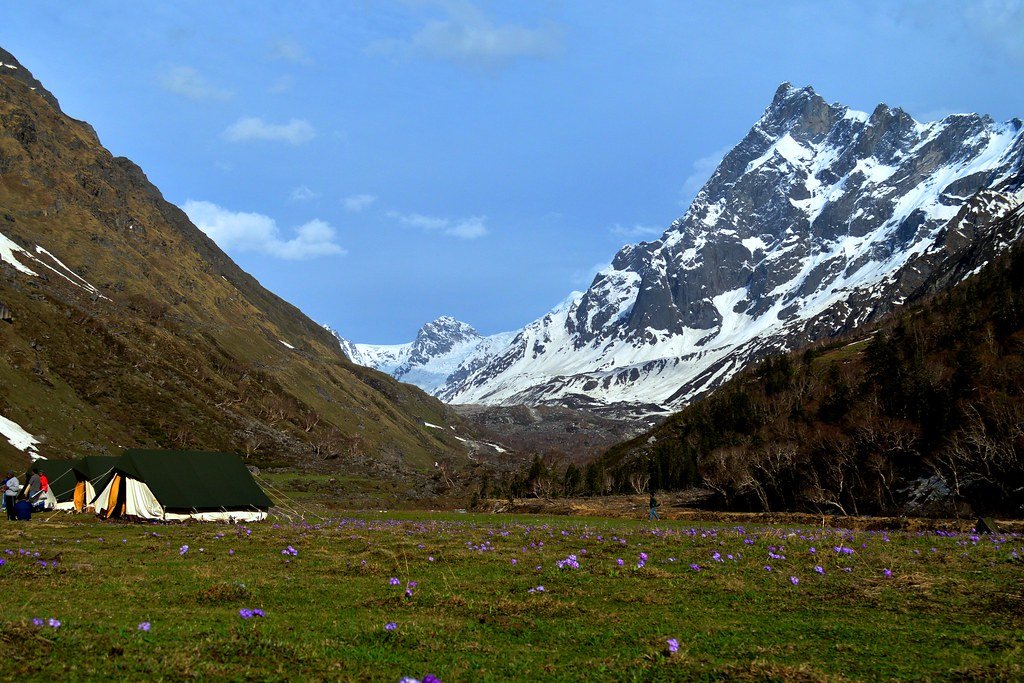
Pingback: Barmer: A Journey Beyond Imagination | Best 10 Places To Visit In Barmer